- Getting around Lijiang. Dont stay in the Old Towns more than 2 days, there is nothing to do. KRISS Oct 9, 2013 05:46
- 2013 Beijing Temple Fair BENNYLAU Feb 26, 2013 03:29
- Malaysian traveling from KUL - LAX vis Shanghai PVG ZATI_DY Jan 3, 2013 20:15
Looking West
- Views: 5698
- |Vote: 1 0
- |Add to Favorites
- |Recommend to Friends
Lanzhou sprawls along the valley of the Yellow River, the second longest river in China with a length of 5,464 km. Her waters – not quite yellow, really more like milky coffee – flow lazily by on their way to the Bohai. We stood on her banks early on the last morning of our visit watching modern speed boats full of tourists racing upstream while age old rafts on twelve bloated sheepskin floats were paddled precariously across the mighty river just as they had for generations. Only now instead of transporting trade goods they were transporting tourist, few of whom avoided getting a little wet.
It was my mother’s strong desire to travel along the ancient and mysterious Silk Road and see the mighty Yellow River on this, her second and perhaps last visit to China. While Lanzhou might not be the most popular of tourist destinations it is a strategically located modern transport hub on both the Silk Road and the Yellow River and many travellers find themselves passing through on route to destinations south, east and west. It seemed only natural that we also found ourselves in Lanzhou.
We’d arrived early the morning before on an overnight sleeper bus from Jiayuguan in the west and our first priority was to find a hotel. The East Bus Station is very conveniently located a block from the train station and we found a great room in the Lanzhou Dasha opposite the station for just Y99 for the three of us. We took breakfast on the street just around the corner. Rice porridge and deep fried dough twists – both filling and delicious when hot. Our next priority was to purchase hard sleepers on the train to Emeishan or Chengdu in Sichuan but we had no joy at the station ticket office. We were told there was nothing available for days so we also checked available flights and costs before returning to the hotel to leave it with their travel staff.
For the remainder of the day we slept, checked mail at an internet café a few blocks away and waited for some news on the tickets. With the prospect of no tickets available for days we contemplated what we could see and do in Lanzhou. Late in the afternoon we got the good news that we would have hard sleepers – tickets were now miraculously available – on tomorrow afternoons train to Chengdu. Perhaps they had put on extra carriages to fill the heavy demand for tickets.
There is plenty to see in the Lanzhou, the capital of Gansu which lies in the eastern portion of the province and in ancient times was the last major garrison and trading city after leaving Xian. Gansu is a long westward stretching province which forms a natural corridor, known as the Hexi between the Qinghai Plateau to the south and the Mongolian deserts and grasslands to the north through which camel caravans once carried goods in and out of China. Lanzhou was one of several garrison outposts that served as oasis on the dry and dangerous journey west. Naturally as Lanzhou developed and grew it spread out along the narrow flood plains of the Yellow River valley which is flanked by steep and often bare, dun coloured hills rising from the surrounding fertile loess plains.
With time to spare we took a leisurely trip downtown catching a bus into the city just before dark for some shopping and dinner. As night falls out here in the desert the temperature drops sharply and during summer the people of Lanzhou take advantage of this dining ‘al fresco’ in the small restaurants, cafes and stalls on the streets surrounding Dongfanghong Square. Lanzhou is famous for spicy beef noodles and we could not visit without trying this local specialty. Another spicy Lanzhou specialty is roujiabing – lamb or pork fried with onion, capsicum and a dash of paprika served inside a flat pocket bread.
One of Lanzhou’s historic attractions is the Iron Bridge, the first ever built on the Yellow River in 1907 replacing a floating bridge called Zhenyuan Bridge built during the fourteenth century. The Iron Bridge at the foot of White Pagoda Hill was reinforced in 1954 and closed to all traffic during our visit for minor repairs. A chairlift crosses the Yellow River to the peak of the hill which overlooks the city. Another chairlift behind Wuquan Gongyuan services the Lanshan Gongyuan, in the mountains to the south of Lanzhou. With its summit at 2100m the temperature up here is often 5ºC cooler than the valley floor. With a fun park and refreshments it’s a great summer escape with a good view of the city and a paved trail, although along walk back down the mountain.
Amongst the many tea houses along the river’s wide tree lined boardwalk and footpaths to the northwest we came across a small natural museum containing two huge water wheels – the first I had scene in China. While these have no doubt been restored they are a magnificent piece of ancient engineering, built along the river back, above a channel of diverted water. Each wheel is made entirely of timber and bamboo without the use of a single nail. The wheel is turned by the pressure of water flowing past and each of the wooden blades carries water to the top of the wheel where it runs off into bamboo half pipes and is then carried away to earth channels which eventually water the rice terraces. These giant wheels were also used to power the stone mills grinding grain into flour. Below the teahouse and museum a boat man wearing a white cap worked with needle, thread and leather hand guard to patch a leaky sheepskin float used for the simple rafts.
While our Silk Road experience was coming to an end we bumped into some ancient yet familiar travellers whose silk road journey may well have begun here in Lanzhou. Monkey magic burst onto our TV screens almost 30 years ago with an illuminating introduction to this legendary figure…….. ‘and the nature of Monkey was irrepressible’. This Japanese TV production adapted from works attributed to a scholarly official named Wu Cheng-en is a mix of mythology, martial arts, magic and morals with a generous dash of humour. Written in the 16th century it is an allegorical fabric of legends, superstitions and popular tales today ranking highly amongst Chinese literary works.
Bronze statues of Monkey and his companions take pride of place on the banks of the Yellow River near the Iron Bridge. On Monkeys Journey to the West he was accompanied by the young mortal monk, Tripitaka with his many human frailties – indecisiveness, cowardice, self-absorption and gullibility – who is the only one to ride a horse. Loveable Pigsy embodied the sins of lust and avarice being easily distracted and seduced by his appetite for physical pleasures but he is loyal if not a little cowardly. Sandy, on the other hand valued patience and skilled service and is undowered with magical powers and great skill in fighting demons.
While this group of unlikely companions – we knew nothing of their history and culture – had been a great source of entertainment to us in the west all those years ago we readily embraced their passion and courage in overcoming the hardships they endured to see good triumph over evil. Since my arrival in China I have often been asked if I knew of the Monkey King. While I was not completely unaware I certainly was ignorant of many things relating to Monkey and his travel companions. I’m not much wiser now about the Monkey King but we have at least one thing in common since I have made my own epic Journey from the West. In Lanzhou we stood side by side looking west.



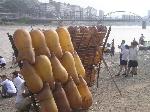
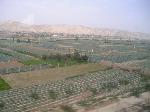
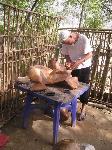
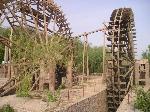
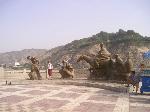
 Copyright © 1998-2026 All rights reserved.
Copyright © 1998-2026 All rights reserved.
1.
Apr 27, 2006 23:18 Reply
CHARAK63 said:
Very exhaustive write-up on lanzhou, I am keen to visit that area in near future.Please read the following para and may be you could help me.
We group of 10 persons want to visit Gansu Sheng and adjoining areas in coming summer. I am a scientist fond of traveling. We watched long, big and shining yellowish green area down small villages called Minle,Shunhua and Dunle on Google earth planet(38.06 -38.16 N & 101.01-101.14 E Elev 9000-9153 ft). It seems near Qilian mountains. It is at the border of Gansu Sheng & Qinghai Sheng provinces. This seems like rice, barley or Rape plantations, but could it be so large?. It looks lush shining green, evenly uniform well planned plantations. Could you please give us information on this ; what is this place, how big is it, its name and how to reach there.
2.
Mar 29, 2006 06:44 Reply
JABAROOTOO said:
Thanks for your compliment but to be honest I don't know much about China and the more I learn the less I know... But I love the adventure and the sense of discovery when I travel. I hope you all do too.
3.
Mar 28, 2006 21:42 Reply
LITTLETREE said:
Very detailed and amazing article. I have never been to Lanzhou. After reading this article, I am eager to go there and have a look at this important hub in the silk road. You know what? Your understanding about the "Journey to the West" makes me feel pretty surprised. You knew a lot about China! Excellent!